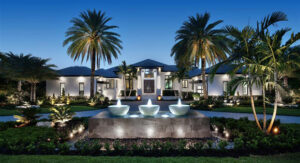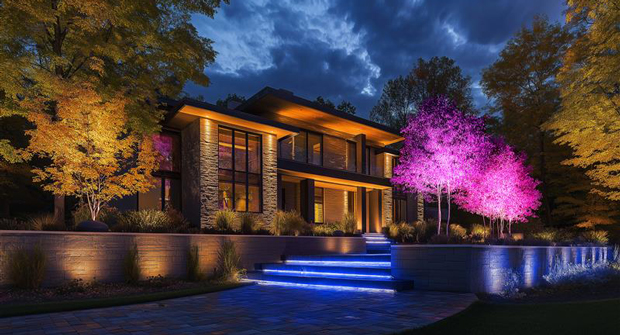The Association of Outdoor Lighting Professionals (AOLP) highlights a new design focus for outdoor lighting: creating lighting that emphasizes architecture and landscaping while reducing skyglow and light pollution. Industry experts Todd Goers, Director of Sales at WAC Lighting, and Kevin Smith, National Technical Support and Trainer at Brilliance LED, provide their insights.
As demand increases for responsible outdoor lighting, the industry is proving that designers don’t need to sacrifice environmental integrity for visual impact. The principle is that quality lighting can be achieved without compromising the night sky.
The meaning behind “Pristine Night, Stunning Light”

A “pristine night” describes outdoor lighting that preserves natural darkness by reducing glare, minimizing light trespass and limiting skyglow. In contrast, “stunning light” refers to the visual impact, contrast and aesthetic appeal achieved through intentional lighting design. The current understanding is that it’s possible to have both.
“To me, a pristine lighting system is one that reflects what the customer really wants to feel when they look out at night,” said Kevin Smith of Brilliance LED. “It’s not just about what looks good—it’s about whether someone feels at peace when they come home. We’re not just placing fixtures; we’re designing emotion.”
“A beautifully designed job isn’t just about lighting up every tree or feature—it’s about restraint,” said Todd Goers of WAC Lighting. “Less is more. When done right, soft illumination can bring out texture and shape in ways that high-output lighting cannot.”
Techniques that support both beauty and responsibility
Designers are using a combination of precise aiming, shielding, dimming and scheduling to provide a refined nighttime experience and reduce environmental disruption.
“Downlighting is key,” said Smith. “It creates beautiful moonlit effects without sending any light into the sky. Grazing walls or highlighting texture with tightly aimed fixtures avoids spill and adds drama.”
“With adjustable beam angles, lumen outputs, and tunable whites, lighting pros can tailor every fixture to its purpose. That means lighting only what needs to be lit and nothing more,” said Goers.
Shielding also plays a big role in achieving this effect. “A few dollars spent on quality cowls and louvers can make all the difference,” said Goers. “You hide the light source, control glare, and let the effect—not the fixture—take center stage.”
Designing for emotion, not just illumination
Part of the movement toward pristine night design is a shift in how lighting is perceived — not just as a tool, but as a means of generating emotional experience.
“Think about how lighting makes you feel in a restaurant,” said Smith. “Bright lights in a fast-food place tell you to eat and leave. Soft, warm lighting in a romantic setting tells you to linger. Outdoor lighting should do the same—set the mood, match the lifestyle, and support relaxation or celebration.”
Looking ahead
As interest in dark sky preservation increases and lighting control technologies become more accessible, the balance of “Pristine Night, Stunning Light” is expected to play a more prominent role in residential and commercial projects.
“Lighting is evolving,” said Goers. “Homeowners are getting more sophisticated. They want elegance and responsibility. With today’s tools and expertise, we can give them both.”


